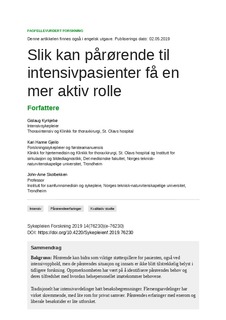| dc.contributor.author | Kirkjebø, Gislaug | |
| dc.contributor.author | Gjeilo, Kari Hanne | |
| dc.contributor.author | Skolbekken, John-Arne | |
| dc.date.accessioned | 2020-03-16T13:10:10Z | |
| dc.date.available | 2020-03-16T13:10:10Z | |
| dc.date.created | 2019-09-13T13:15:59Z | |
| dc.date.issued | 2019 | |
| dc.identifier.citation | Sykepleien Forskning. 2019, (14), 1-26. | nb_NO |
| dc.identifier.issn | 1890-2936 | |
| dc.identifier.uri | http://hdl.handle.net/11250/2647002 | |
| dc.description.abstract | Background: Family members can provide crucial support for the patient, including during stays in an intensive care unit, but the family members’ situation and efforts have not been sufficiently elucidated in earlier research. The focus has been on identifying the family members’ needs and their satisfaction with how healthcare personnel meet these needs.
Visiting hours in intensive care units have traditionally been restricted. Multi-bed wards were sometimes considered overwhelming, with limited opportunities for privacy. Little research is available on family members’ experiences with single rooms and flexible visiting hours.
Objective: We wanted to obtain more knowledge about families’ experiences in connection with prolonged stays in intensive care units following heart surgery in a unit with single rooms and flexible visiting hours.
Method: A grounded theory-based study, including semi-structured interviews with six family members of intensive care patients. The data were analysed in accordance with constructivist grounded theory (CGT).
Results: Patients’ family members sought and fostered a sense of security by being present for the patient and helping the patient to get through the intensive care treatment. They found that single rooms, short waiting times, flexible visiting hours, information, trust in healthcare personnel, privacy and a calm atmosphere in the unit enabled them to play an active role in which they could support and protect the patients.
Family members had a strong desire to make the patient and other relatives feel more secure in an uncertain, unfamiliar, busy and challenging situation characterised by fluctuating hope and emotions. During visits, they were primarily concerned with supporting the patient and protecting them from their own reactions and difficult topics of conversations. Strong impressions and concern for the patient sometimes made it difficult to comprehend important information given by healthcare personnel.
Conclusion: Family members wanted to play a role in making the patients feel more secure during their stay in intensive care, and they felt that their efforts were an important resource. A calm atmosphere, trust in the healthcare personnel and private visits with the patients made it possible for them to support and care for the patients. The findings challenge traditional perspectives on the roles of patients’ families, where families are ascribed a passive recipient role as a visitor. | nb_NO |
| dc.language.iso | eng | nb_NO |
| dc.publisher | Norsk Sykepleierforbund (Norwegian Nurses League) | nb_NO |
| dc.relation.uri | https://static.sykepleien.no/sites/default/files/pdf-export/pdf-export-76230.pdf?c=1564728664 | |
| dc.title | How intensive care patients’ family members can play a more active role | nb_NO |
| dc.title.alternative | Slik kan pårørende til intensivpasienter få en mer aktiv rolle | nb_NO |
| dc.type | Journal article | nb_NO |
| dc.type | Peer reviewed | nb_NO |
| dc.description.version | publishedVersion | nb_NO |
| dc.source.pagenumber | 1-26 | nb_NO |
| dc.source.journal | Sykepleien Forskning | nb_NO |
| dc.source.issue | 14 | nb_NO |
| dc.identifier.doi | 10.4220/Sykepleienf.2019.76230 | |
| dc.identifier.cristin | 1724471 | |
| dc.description.localcode | Copyright © 2019 The Authors. Published by Norsk Sykepleierforbund (Norwegian Nurses League) | nb_NO |
| cristin.unitcode | 1920,10,0,0 | |
| cristin.unitcode | 1920,6,0,0 | |
| cristin.unitcode | 194,65,25,0 | |
| cristin.unitcode | 194,65,20,0 | |
| cristin.unitname | Klinikk for thoraxkirurgi | |
| cristin.unitname | Klinikk for hjertemedisin | |
| cristin.unitname | Institutt for sirkulasjon og bildediagnostikk | |
| cristin.unitname | Institutt for samfunnsmedisin og sykepleie | |
| cristin.ispublished | true | |
| cristin.fulltext | original | |
| cristin.qualitycode | 1 | |
